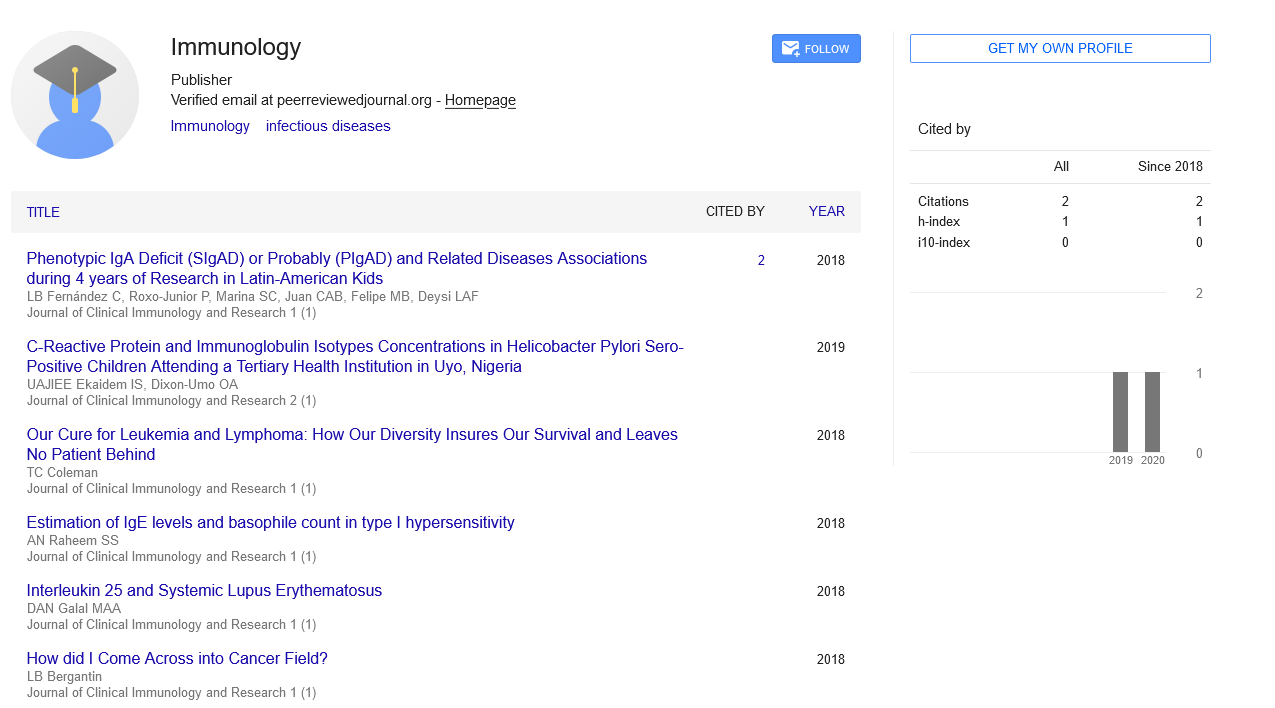Commentary, J Clin Immunol Res Vol: 6 Issue: 2
Inflammatory Immunity Response for Defense Mechanism against Diseases
Xiang Mio*
1Department of Infectious Disease, Ningxia Medical University, Yinchuan, China
*Corresponding Author: Xiang Mio,
Department of Infectious Disease, Ningxia
Medical University, Yinchuan, China
E-mail: mioxiang@gmail.com
Received date: 15 May, 2023, Manuscript No. JCIR-23-104721;
Editor assigned date: 17 May, 2023, PreQC No JCIR-23-104721 (PQ);
Reviewed date: 01 June, 2023, QC No. JCIR-23-104721;
Revised date: 08 June, 2023, Manuscript No JCIR-23-104721 (R);
Published date: 16 June, 2023, DOI: 10.4172/JCIR.100079
Citation: Mio X (2023) Inflammatory Immunity Response for Defense Mechanism against Diseases. J Clin Immunol Res 6:2.
Abstract
Description
Inflammation is a fundamental process that plays a pivotal role in the immune response. It serves as the body's natural defense mechanism against infection, injury, and other harmful stimuli. However, when the immune system's response becomes dysregulated, inflammation can become chronic and contribute to the development of various diseases.
The immune system and inflammation are intricately linked processes within the body that play major roles in maintaining health and fighting off infections. While inflammation is a natural response of the immune system, the relationship between the two is complex and can have both beneficial and detrimental effects on the body.
The immune system is a highly sophisticated defense mechanism that protects the body against harmful substances, such as bacteria, viruses, and toxins. It is composed of various cells, tissues, and organs that work together to identify and eliminate foreign invaders while preserving the body's own healthy cells.
Inflammation, on the other hand, is the body's response to infection, injury, or irritation. It is a protective mechanism designed to remove harmful stimuli, initiate the healing process, and restore normal tissue function. When the immune system recognizes an invader or perceives tissue damage, it triggers a cascade of events that lead to inflammation.
Inflammation is a complex biological response characterized by redness, swelling, heat, and pain in the affected area. It is triggered by the release of chemical signals called inflammatory mediators, including cytokines, chemokines, and prostaglandins. These mediators act as messengers, recruiting immune cells to the site of infection or injury.
Immune cells in inflammation
Several immune cells play important roles in initiating and regulating the inflammatory response. Neutrophils are the first responders, swiftly migrating to the site of inflammation to engulf and destroy invading pathogens. Macrophages, monocytes, and dendritic cells also participate in inflammation, releasing cytokines and presenting antigens to activate other immune cells.
T lymphocytes (T cells) have a significant impact on inflammation. Different subsets of T cells, such as Th1, Th2, Th17, and regulatory T cells (Tregs), have distinct roles in modulating the inflammatory response. Th1 cells produce pro-inflammatory cytokines, promoting inflammation against intracellular pathogens, while Th2 cells promote allergic responses and dampen inflammation. Th17 cells contribute to the pathogenesis of autoimmune diseases by producing inflammatory cytokines, and Tregs suppress excessive inflammation to maintain immune homeostasis.
To prevent excessive inflammation, the immune system employs mechanisms for resolution and regulation. Anti-inflammatory cytokines, such as Interleukin-10 (IL-10) and Transforming Growth Factor-beta (TGF-β), help dampen inflammation and promote tissue repair. Specialized pro-resolving lipid mediators, like resolvins and lipoxins, actively facilitate the resolution of inflammation. These include Tregs which suppress the activity of other immune cells, limiting inflammation and maintaining immune balance. These cells produce anti-inflammatory cytokines and act as guardians against autoimmune reactions.
The immune system and inflammation are intricately linked processes within the body that play major roles in maintaining health and fighting off infections. While inflammation is a natural response of the immune system, the relationship between the two is complex and can have both beneficial and detrimental effects on the body.
The immune system is a highly sophisticated defense mechanism that protects the body against harmful substances, such as bacteria, viruses, and toxins. It is composed of various cells, tissues, and organs that work together to identify and eliminate foreign invaders while preserving the body's own healthy cells.
Inflammation, on the other hand, is the body's response to infection, injury, or irritation. It is a protective mechanism designed to remove harmful stimuli, initiate the healing process, and restore normal tissue function. When the immune system recognizes an invader or perceives tissue damage, it triggers a cascade of events that lead to inflammation.
 Spanish
Spanish  Chinese
Chinese  Russian
Russian  German
German  French
French  Japanese
Japanese  Portuguese
Portuguese  Hindi
Hindi 